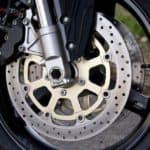We're an Affiliate. If you use our partner links we earn a commsission at no extra cost to you. Thank you for your support! Read the full disclosure here.
Your getting ready for your ride and it doesn’t feel too bad outside. Sometimes it’s not too bad when you’re going, other times it’s a bad decision. Today we talk about wind chill on a motorcycle and making sure that you’re prepared.
My chilly war story
In April of 2017 my gal and I decided to take a weekend trip with friends to Sedona, Arizona through Flagstaff, Arizona.
Living in the Vegas area, you tend to forget about other areas not only being cold, but the elevation in other locations that makes it cold.
So, with poor planning (we had never been there) we set out, not knowing how cold Flagstaff can get in the month of April (I should have known better).
It’s never a good sign when you’re pulling into town and there’s snow on the shoulders of the highway!
I’ll save the full story for another time, but we made it to Sedona (it was a lot of fun) and stayed the night in a small town near there.
The problem was the next day.
A cold front moved in that we didn’t plan on and we had to head back to the Vegas area. This had the potential to really suck the fun out of this quick getaway!
And it almost did…
The ambient temperature was already chilly, but when you throw the wind chill from the ride on the motorcycle, our legs got cold in a hurry.
I also didn’t have any warmer riding gloves with me. My grips have rubber on them, but metal between the rubber. In extreme temperatures you feel it.
We had our full motorcycle jacket setup thinking that was enough. We didn’t count on how cold our legs would get or how cold my hands would get.
Fortunately, we weren’t completely unprepared. We had our rain basic pants with us, which did a great job holding the body heat in so we could make the trip back.
It wasn’t the ambient air when we were stopped that was the problem. The wind chill when we were moving was.
That and my poor planning.
What is wind chill
In some ways wind chill is a bit of a mirage, so to speak.
There are other factors such as moisture that can play into wind chill, but we’ll keep this basic for now.
Wind chill (or wind chill factor) is how cold your body feels, or is perceived to feel as a decrease in the ambient air temperature due to the flow of air on your body.
The opposite of this effect is known as the ‘heat index’.
Wind chill isn’t the air actually getting cooler, but the perception that it is because of how our bodies react to it.
This makes measuring wind chill a bit nebulous, and in fact there really is no actual measurement for wind chill. Wind chill factor is just an attempt by humans to try and measure the effect cold on our bodies as it’s affected by wind.
The numbers for wind chill are always going to be lower than what you see for air temperature depending on the formula that’s used to calculate it.
That’s the sticking point;
There are different ways that wind chill can be calculated which can make the whole thing a bit of a moving target.
Other approaches to wind chill
There are several different formulas that are used worldwide to calculate wind chill or wind chill factor.
Nailing all this down goes back to the fact that wind chill is a feeling of perception of how cold it is due to wind.
The reason that calculating wind chill is a bit of a moving target is due to not having a worldwide acceptable standard or measurement that the world can agree on.
As it stands, Europe has their way and the U.S. has their own for example. In fact each weather bureau’s in each country use their own formula.
The U.S. and Canada share a wind chill model that is in wide use the National Weather Service.
The North American wind chill equation
The wind chill index used by the U.S. and Canada was designed to help the public be able to protect itself and provide some kind of uniformity for North America.
Here’s what the North American wind chill index uses:
Calculates wind speed at an average height of about five feet off the ground, which is around the same height as an average human face. It’s based on readings from the national standard height of 33 feet which is the typical height of an anemometer.
It’s based on the latest heat transfer theory or heat lost from the body to it’s surroundings during cold and breezy days (also windy days).
Based on the human face model which is the most exposed part of the human body to the elements.
It uses a standard factor for skin tissue and makes an assumption that there is no sunlight.
Lowers calm wind threshold to 3 mph.
So your saying there’s no such thing as wind chill?
Not at all. Wind chill is very real and dangeous.
When I was riding back from Sedona Arizona my legs freezing as I was cruising down the highway. It’s all based on the wind making it feel colder than it really is.
That’s the point with trying to calculate wind chill;
It’s perception. My perception was that my legs were freezing off based on how the wind was hitting my legs.
Wind chill is very real. How it’s calculated is based on human perception, which makes quantifying it a bit of a moving target.
Ok, I’ll move to where it’s warm and avoid it
My Sedona story is proof that won’t work!
In fact, in may give you a false sense of security.
If you’re on a long ride on cool day and you don’t wear the proper gear for the occasion you run the risk of being exposed or becoming hypothermic.
That was the point of my story. While I didn’t become hypothermic I was miserable.
I planned poorly due to thinking that I wasn’t going to hit any temperature fluctuations and it could’ve cost me.
If I would have run into moisture in addition to the cold, it would have been a different story for both myself and my passenger. Probably would’ve either booked an extra night in a hotel or hospital.
Being cold and wet on wet roads sucks, I don’t recommend it.
Where I live even if it’s 70 outside, if you jump on a motorcycle at highway speed you’re going to need a jacket.
How to deal with wind chill on a motorcycle
To fight off wind chill the first step is to prepare yourself for your trip.
In my Sedona war story, I failed to plan ahead sufficiently for any potential cold snap. I got to caught up on my little Vegas bubble, like I talked about in the previous section.
Even if it’s a last minute ride, take some time and at least do some searches on your cell phone and perform basic trip planning.
Ask yourself:
What is the elevation where I’m headed?
Have some idea of the elevation of your destination above sea level.
On another trip with my lady, we went to Arrowhead California, which is up in the mountains near Big Bear. We went from the Valley floor of the desert with great temperatures, to running into heavy fog half way up the mountains. This of course, presented all kinds of issues.
I’m not sure if the weather app would’ve have had any info for me, but I didn’t check either.
What are the average temperatures this time of year?
Make sure you understand the potential for colder temperatures or even freezing temperatures. This is where knowing the elevation will come into play.
Does the location every get snow?
Even if it doesn’t snow often, make sure you get some basic local info for the potential of running into snow.
On our Sedona trip, we saw quite a bit of snow on the shoulders of the road entering Flagstaff.
Let the pucker begin.
Will you experience freezing temperature at the elevation your traveling?
Just about everyone knows, but in case you don’t, freezing temperatures occur at 32 degrees Fahrenheit.
I’m no scientist, but as you go higher in elevation your potential to encounter freezing temperatures also increases.
Have the proper gear with you
I try and keep a couple pairs of gloves with me unless I know for an absolute FACT that I won’t be running into cold temps (Vegas to San Diego in July for ex).
Just like any other cold weather excursion, your going to want to dress in layers so you can add or remove clothing as necessary.
I tend to be a fair weather rider (as much possible, yes I’m that guy), but here’s how I do my layering if I know I’m going to possibly encounter cold.
Head, Upper body and hands:
Head
I’ll put on Balaclava if I can’t stand the cold wearing just my helmet.
I’ve used a full face and modular helmet in the past. I now use a three quarter helmet with a face shield.
Upper body
My usual thin/breathable summer long sleeve shirt. This is my base shirt.
Sweatshirt or thicker long shirt. I may also substitute this for a zip up wool style vest, due to getting my arms into my jacket.
Leather Vest. Just my plain ‘ol leather vest on top of the other two layers.
Motorcycle jacket. This nice thing, is that my motorcycle jacket itself has in inner and outer shell, which really gives me two more layers.
My hands
If I know I have the potential for cold weather, I will keep two pairs of gloves with me:
My everyday riding gloves and a cold weather set of riding gloves.
Once glove hack I’ve read about involves wearing rubber gloves, then putting your gloves on. Overall not a bad strategy, but keep in mind your hands will get real sweaty when you take them off.
I keep a pair rubber gloves with me for emergencies.
Legs and Feet
If I REALLY think I have the potential for my legs to get cold, I start with long johns.
After that, I’ll throw on my jeans or pants that I’ve designated as my riding pants.
For the final layer, I have a pair of rain pants that actually hold the heat in quite well for me. I’d like to point out that if you don’t have the leg protection from your fairing (like I do with a Goldwing) these 3 layers will not be enough.
I know this isn’t the ideal setup for the cold. In fact, my next purchase will be a good pair of motorcycle pants in the near future.
But since I’m not doing crazy adventure riding through the mountains this works for me.
My Feet
A pair of wool socks or two and nice pair of boots. Simple.
I will be looking around something more specialized in the near future.
If you’re hard core cold weather rider and into extreme weather and pushing yourself (yada, yada) this may not work for you!
Again, I tend to be a fair weather rider.
My philosophy is simple: I ride for fun not to be miserable. I’m prepared for bad weather and will deal with it but I don’t seek it out!
Keep in mind
Remember that if you’re going to be riding in cold weather and staving off wind chill, layering your clothing is going to be key.
Layering is going to help keep your body insulated from the air rushing over you (which makes you feel the wind chill) and prevent your body heat from being blown away from you.
You’ll want to both layer clothing and wind proof as much as possible. Of course this all gets tricky on a long ride when you only have so much room for storage on the motorcycle!
Why is wind chill dangerous?
Like we’ve already talked about, wind chill is not an actual temperature, but a perception of how cold we feel based on wind cold temperatures that we’re exposed to.
While the wind chill factor is a bit of a moving target (because it’s based on perception), the effects of wind chill are very real.
If you’re exposed to wind chills that are extreme (below zero depending on how you measure it) your body will experience frostbite and/or hypothermia within minutes of exposure.
This was the whole reason to try and quantify wind chill in the first place; Have some way to forecast human and animal exposure to extreme cold weather conditions.
Frostbite vs Hypothermia
Frostbite is actual damage to your bodies tissues as a result of being exposed to severe cold. The damage results in the actual moisture in the tissue crystalizing (or turning to ice).
This isn’t something to mess around with, and you should get the affected person to medical help as soon as possible.
Frostbite occurs in the body at an approximate wind chill of -20 degrees Fahrenheit. Its possible to have frostbite and hypothermia at the same time.
Hypothermia occurs when the extremities of the body are very cold and your overall body temperature drops below about 95 degrees Fahrenheit.
Becoming hypothermic is nothing to take lightly. If it doesn’t kill you, you may suffer from lasting problems with you kidneys, pancreas and liver.
Best temperature for motorcycle riding
So, what’s the best temperature?
This is purely subjective question, but it boils down to what you can stand and what your prepared for.
If I had to pick a ‘best’ or ‘favorite’ temperature range, it’s about 75 – 80 degrees, nice sunny day.
That’s my ‘goldilocks’ zone.
That’s me, but again, everyone’s different.
The takeaways from all this
Wind chill is a real thing, with real consequences and you can really get yourself hurt if your not properly prepared for the cold weather.
Where It can get a bit dicey, is wind chill is measured.
If you perform a search for wind chill maps, you’ll get all kinds of results from different agencies and people making their own wind chill charts.
Here’s a link to NOAA’s wind chill chart if your looking for something that’s official (at least for the U.S. and Canada) to at least give you an idea of what you could be facing.
Whether it’s wind chill on a motorcycle or you’re Just enjoy the cold weather, make sure you employ proper planning, have the right gear and some kind of a plan in case you run into unexpected chilly temperatures.
Let me know in the comments below your thoughts, experiences and gear to keep you safe.






